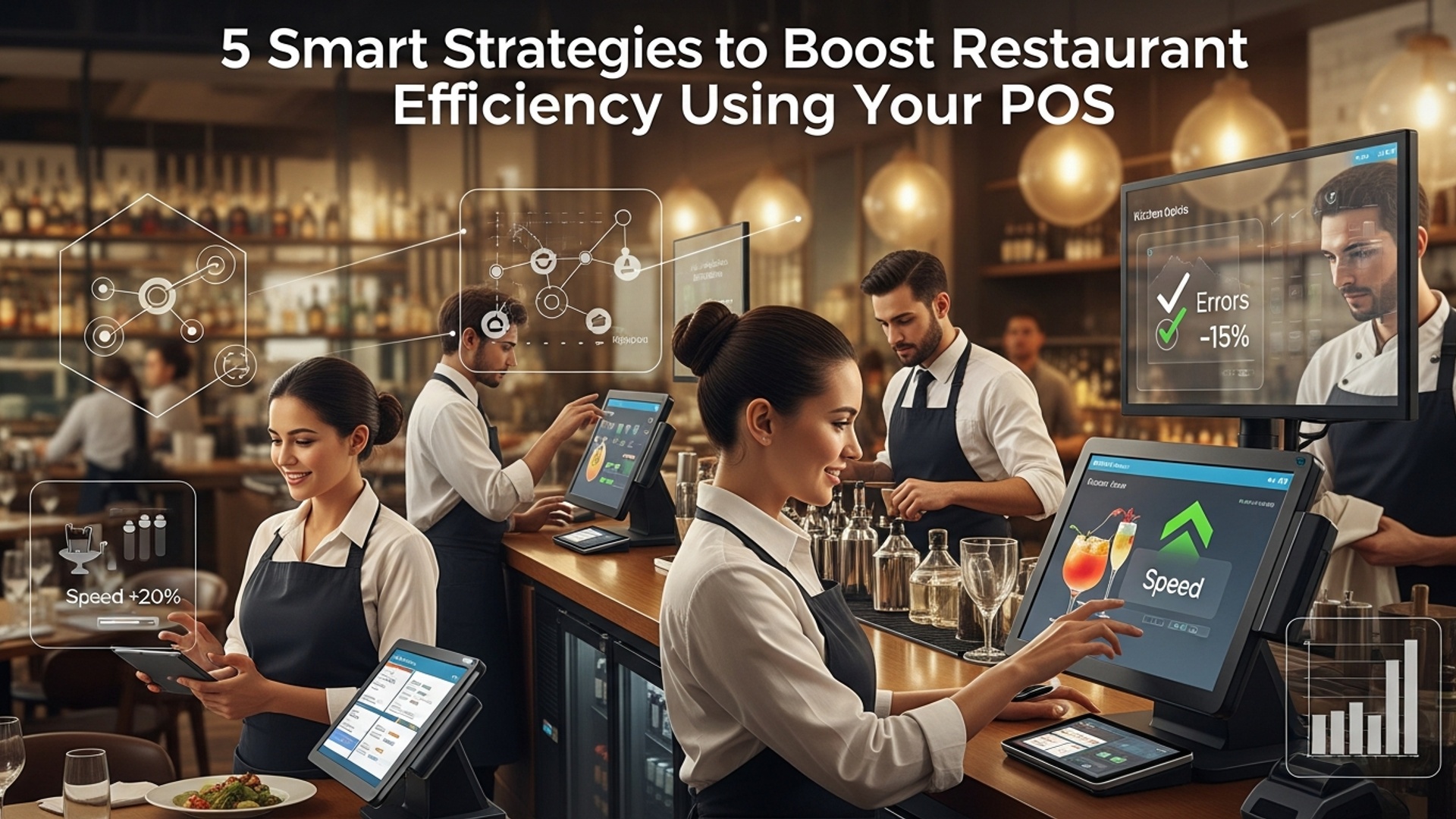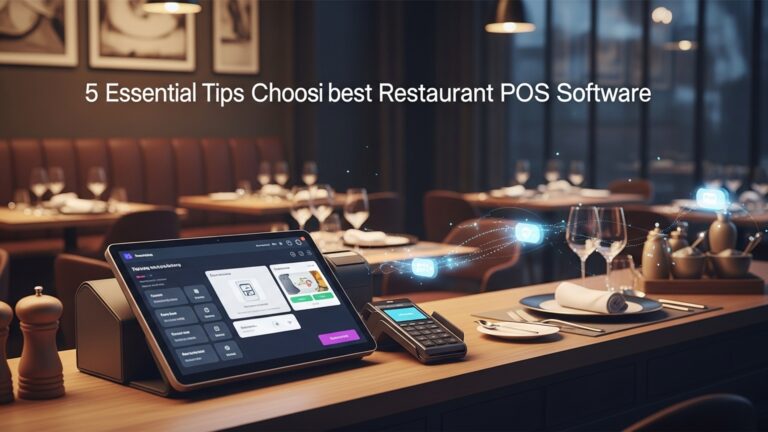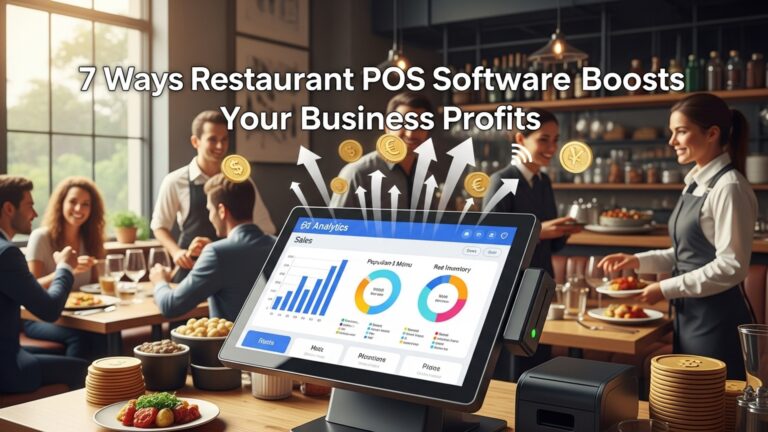Master 5 Smart Strategies to Boost Restaurant Efficiency Using Your POS
In today’s fiercely competitive restaurant landscape, marked by escalating operational costs and persistent staffing challenges, merely processing transactions is no longer enough. Forward-thinking restaurateurs recognize that advanced restaurant POS software transcends its traditional role, transforming into a strategic hub for operational excellence. Modern systems, leveraging real-time data analytics, offer unparalleled opportunities to identify and eliminate bottlenecks, from optimizing inventory automation to streamlining table turns and enhancing order accuracy. This shift empowers operators to move beyond reactive problem-solving, proactively utilizing deep insights to significantly boost efficiency and secure a sustainable competitive edge.

Understanding the Power of Your Restaurant POS Software
In the fast-paced world of gastronomy, efficiency isn’t just a buzzword; it’s the bedrock of success. At the heart of a truly efficient restaurant operation lies the often-underestimated tool: your Restaurant POS software (Point of Sale). Far more than just a cash register, modern POS systems are comprehensive management hubs designed to streamline every facet of your business, from front-of-house operations to back-office analytics. But what exactly is a POS system in this context?
A Restaurant POS software is a digital system that processes transactions and records sales. its capabilities extend dramatically beyond that. It integrates various operational components, including order management, inventory tracking, customer relationship management. sales reporting, into a single, cohesive platform. Think of it as the central nervous system of your restaurant, ensuring all parts communicate effectively and operate smoothly. For instance, when a server punches in an order on a handheld device, that insights is instantly relayed to the kitchen, deducted from inventory. logged for sales analysis – all thanks to robust Restaurant POS software.
Historically, restaurants relied on manual methods: paper order pads, separate cash registers. handwritten inventory sheets. This fragmented approach often led to errors, delays. a lack of real-time insight. The evolution of Restaurant POS software has revolutionized this, offering a comprehensive digital solution that addresses these pain points directly, empowering owners and managers to make informed decisions and enhance the dining experience.
1. Streamlining Order Management and Kitchen Operations
One of the most immediate and impactful ways your Restaurant POS software boosts efficiency is by revolutionizing how orders are taken, processed. fulfilled. Manual order taking is prone to errors, illegible handwriting. miscommunication between front-of-house and kitchen staff. A modern POS system eliminates these bottlenecks, ensuring accuracy and speed from the moment a customer places their order.
- Digital Order Taking
- Instant Kitchen Display System (KDS) Integration
- Table Management & Course Timing
Servers can input orders directly into a terminal or handheld device. This reduces errors caused by manual transcription and ensures every item, modification. special request is accurately recorded. For example, if a customer requests “no onions” on their burger, the POS allows the server to select this modification with a tap, rather than scribbling a note that might be missed.
Once an order is entered, it’s immediately sent to the kitchen display system (KDS) or a printer. This means chefs see new orders instantly, organized by course, table number, or preparation time. This real-time communication minimizes wait times, prevents lost tickets. allows the kitchen to manage workflow more effectively. “We’ve seen our average ticket times drop by 15% since implementing a KDS integrated with our Restaurant POS software,” notes Sarah Chen, owner of ‘The Daily Dish’ bistro. “It’s a game-changer for service speed.”
Advanced Restaurant POS software often includes integrated table management features. Servers can see which tables are occupied, waiting for food, or ready for the check. This helps in seating new guests efficiently and timing courses perfectly. For instance, a server can “fire” an appetizer course to the kitchen. then, based on estimated prep times, “fire” the main course later, ensuring dishes arrive at the optimal moment.
Consider a busy Saturday night: without a robust POS, a server might accidentally write down the wrong table number, leading to an order going to the wrong guest, or a modifier being forgotten. With Restaurant POS software, such errors are significantly minimized, leading to happier customers and less food waste.
2. Optimizing Inventory Control and Reducing Waste
Food cost is a significant expense for any restaurant. inefficient inventory management can quickly erode profits. Your Restaurant POS software is an indispensable tool for gaining precise control over your stock, minimizing waste. ensuring you always have the right ingredients on hand.
- Real-time Stock Tracking
- Automated Reordering & Alerts
- Recipe Management & Portion Control
- Vendor Management Integration
Every time an item is sold through the POS, the corresponding ingredients are automatically deducted from your inventory. This provides a real-time snapshot of your stock levels. Imagine selling 20 cheeseburgers; your POS instantly subtracts 20 burger patties, 20 buns. the associated cheese and condiments from your digital inventory. This level of detail is almost impossible to achieve manually.
Many Restaurant POS software solutions can be configured to trigger alerts when inventory levels for specific items fall below a predefined threshold. Some even offer automated reordering capabilities, sending purchase orders directly to suppliers. This prevents stockouts of popular items and reduces the risk of over-ordering perishable goods, which often leads to spoilage.
By linking recipes to your POS system, you can track the exact cost of each dish and ensure consistent portion sizes. This not only helps control food costs but also maintains the quality and consistency that customers expect. If a chef uses 150g of chicken breast for a dish, the POS will deduct 150g from the chicken breast inventory, providing granular tracking.
Some advanced Restaurant POS software allows for direct integration with vendor catalogs and ordering systems. This streamlines the procurement process, making it easier to compare prices, place orders. track deliveries, further enhancing efficiency and cost savings.
According to a study by the National Restaurant Association, food waste accounts for a significant portion of a restaurant’s operating costs. By leveraging the inventory management features of your Restaurant POS software, you can drastically reduce this waste, leading to a healthier bottom line. For instance, a restaurant owner might notice through POS reports that a particular ingredient consistently expires before being used, prompting them to adjust future order quantities.
3. Enhancing Customer Relationship Management (CRM)
In today’s competitive dining landscape, building strong customer relationships is paramount. Your Restaurant POS software can be a powerful CRM tool, helping you grasp your clientele better, personalize their experience. foster loyalty.
- Customer Databases
- Loyalty Programs & Rewards
- Personalized Marketing
- Feedback Collection
Many POS systems allow you to collect and store customer details, such as names, contact details, order history. preferences. This can be done by integrating with online ordering platforms or loyalty programs. For example, if a customer frequently orders a specific dish or has dietary restrictions, this data can be logged.
Implementing loyalty programs through your Restaurant POS software encourages repeat business. Customers can earn points, receive discounts, or get special offers directly managed by the POS. When a loyal customer dines, their points are automatically updated. any eligible rewards are applied at checkout. This not only rewards loyal patrons but also provides valuable data on their purchasing habits.
With customer data at your fingertips, you can create targeted marketing campaigns. Want to send a birthday discount to customers who celebrated their birthday this month? Your POS data can help identify them. Looking to promote a new vegan dish? Segment your customer base by past orders to target those who have ordered similar items. This precision marketing is far more effective than generic promotions.
Some Restaurant POS software integrates with feedback tools, allowing customers to provide reviews directly after their meal or online. This immediate feedback loop is invaluable for identifying areas for improvement and addressing issues before they escalate.
Consider a regular customer, Mr. Smith, who always orders the steak medium-rare and has a penchant for a specific Cabernet Sauvignon. When he dines, the server, prompted by the POS, can subtly confirm his usual preferences, making him feel recognized and valued. This level of personalized service, facilitated by your Restaurant POS software, transforms a simple meal into a memorable experience, driving repeat visits and positive word-of-mouth.
4. Data-Driven Decision Making with Sales Analytics
Perhaps one of the most transformative capabilities of modern Restaurant POS software is its ability to collect, examine. present vast amounts of data in actionable ways. Gone are the days of guessing what’s selling or when your busiest periods are; now, you have precise data to guide your strategic decisions.
- Sales Reports & Trends
- Peak Hour Identification
- Menu Optimization
- Employee Performance Tracking
Your POS generates detailed reports on sales performance, breaking down data by hour, day, week, month, or even year. You can review sales by menu item, category, server, or payment type. For instance, a report might show that your ‘Spicy Chicken Sandwich’ consistently outperforms all other lunch items on Tuesdays and Thursdays.
By analyzing sales volume and transaction speed, your Restaurant POS software can clearly identify your busiest hours and days. This data is crucial for optimizing staffing levels, ensuring you have enough hands on deck during rushes without overstaffing during slower periods. For example, if data shows 7-9 PM is consistently your peak, you can schedule more servers and kitchen staff during those hours.
Armed with sales data, you can make informed decisions about your menu. Which dishes are your top sellers? Which are underperforming? Which items have the highest profit margins? You might discover that a low-selling item is also expensive to produce, making it a prime candidate for removal, or that a popular dish could be made even more profitable with a slight adjustment to its price or ingredients. This is where the concept of “menu engineering” truly shines, powered by your Restaurant POS software.
POS reports can track individual server performance, showing average check sizes, sales per hour. upselling rates. This data can be used for performance reviews, identifying training needs. even recognizing top performers.
A hypothetical case study: ‘Pizzeria Italia’ used its Restaurant POS software to examine sales data over six months. They discovered that their “Gourmet Veggie Pizza,” despite having a high ingredient cost, was a consistent top-seller and had an excellent profit margin. Conversely, a specialty pasta dish was rarely ordered and had a high preparation time. Based on this data, they decided to slightly increase the price of the Veggie Pizza and remove the pasta dish, replacing it with a more cost-effective and faster-to-prepare alternative. This data-driven decision, impossible without robust POS analytics, significantly boosted their overall profitability.
5. Boosting Staff Performance and Reducing Errors
Your Restaurant POS software isn’t just a tool for managers; it’s a powerful assistant for your staff, enabling them to perform their duties more efficiently, accurately. with less stress.
- Simplified Order Entry
- Reduced Training Time
- Accurate Cash Handling & Reconciliation
- Shift Management & Time Tracking
- Upselling and Cross-selling Prompts
Modern POS interfaces are designed to be intuitive and user-friendly. Servers can quickly navigate menus, apply discounts, split checks. manage tables with minimal training. This reduces the learning curve for new staff and minimizes errors during busy periods. Instead of memorizing complex menu codes or pricing, staff can rely on the visual interface of the POS.
Because the system is often intuitive, new hires can be trained on the POS much faster than traditional, manual systems. This saves valuable time and resources for the restaurant. “Our new hires are proficient with the POS within a day, compared to the week it used to take with our old manual system,” shares Mark Davies, General Manager of a popular diner.
Restaurant POS software precisely tracks all transactions, including cash, credit cards. gift cards. This makes end-of-day reconciliation much simpler and more accurate, significantly reducing discrepancies and potential theft. Servers know exactly how much cash they should be remitting. managers have a clear audit trail for all financial activities.
Many POS systems include integrated time clock functionalities, allowing employees to clock in and out directly through the system. This automates payroll data collection, prevents “buddy punching,” and provides accurate records for labor cost analysis. Managers can also use the POS to manage staff schedules, ensuring optimal coverage.
Some advanced Restaurant POS software can be configured to prompt servers with suggested upsells or cross-sells based on the items a customer has ordered. For example, if a customer orders a burger, the POS might suggest “Add a side of our truffle fries?” This empowers staff to increase average check sizes without needing extensive product knowledge memorization.
By empowering staff with efficient tools and reducing their cognitive load, Restaurant POS software not only improves individual performance but also contributes to a more harmonious and productive work environment. Errors are minimized, service speeds up. staff can focus more on providing excellent customer service rather than struggling with administrative tasks.
Conclusion
Mastering your POS system transforms it from a mere transaction tool into the operational heartbeat of your restaurant. To truly boost efficiency, start by delving into your system’s analytics; my personal tip is to dedicate 15 minutes weekly to review peak hours and best-selling items, which can inform staffing and inventory. Leverage features like real-time inventory management to minimize waste, as I’ve seen this reduce food costs by up to 10% in some establishments. implement integrated loyalty programs, a current trend, to personalize guest experiences and drive repeat business. Beyond streamlining orders and payments, empower your team by training them to utilize the POS for everything from table management to split checks, fostering a seamless front-of-house flow. Think about recent developments, like integrating online ordering directly with your kitchen display system, which drastically cuts order errors and speeds service. By proactively engaging with these smart strategies, you’re not just improving daily operations; you’re building a more agile, profitable. future-ready restaurant. The power to unlock unparalleled efficiency is already at your fingertips – seize it.
More Articles
7 Must-Have Features Your Restaurant POS Software Needs to Thrive
Guide 10 Best Practices for Optimizing Your Restaurant POS Performance
Discover 10 Ways Restaurant POS Software Can Grow Your Business Profitably
Learn 7 Ways Restaurant POS Software Boosts Your Business Efficiency
FAQs
How can my POS really make my restaurant run smoother?
Your POS is more than just a cash register! It’s a central hub that can automate tasks, reduce errors. give you valuable data. Think faster order taking, accurate inventory. quicker payment processing, all leading to a much more efficient operation.
My servers struggle with order accuracy and speed. Can a POS help with that?
Absolutely! A good POS system streamlines the entire ordering process. Servers can input orders directly at the table or counter, send them instantly to the kitchen. easily handle modifications or special requests. This dramatically reduces errors and speeds up service, making both staff and customers happier.
We have a lot of food waste and run out of popular items too often. How does a POS tackle inventory issues?
Your POS can be a game-changer for inventory. It tracks ingredients in real-time as items are sold, alerts you when stock is low. even helps identify what’s selling well and what’s not. This means less waste, fewer stock-outs of customer favorites. smarter purchasing decisions.
What kind of insights can I get from my POS to make better business decisions?
A ton! Your POS collects data on everything from peak sales hours and most popular dishes to staff performance and average ticket size. These reports help you optimize staffing, refine your menu, interpret customer preferences. ultimately boost your profits by making data-driven choices.
Does a POS help manage my team better?
Yes, many modern POS systems come with features that significantly help with staff management. You can use it for time tracking, managing shifts. even tracking individual server performance. This simplifies payroll, helps identify top performers. ensures you’re adequately staffed during busy periods.
Beyond internal operations, how does a POS improve things for my customers?
Guests benefit directly from an efficient POS! They get faster, more accurate orders, quicker payment processing. a smoother overall dining experience. Plus, many POS systems support loyalty programs and gift cards, allowing you to reward repeat customers and offer personalized promotions.
Is it hard to set up these efficiency strategies with my existing POS?
Not usually a complete overhaul! Most modern POS systems have these efficiency features built-in. they might need some configuration and staff training. Start by focusing on one or two strategies that address your biggest pain points. Your POS provider can often guide you through the setup and help you unlock its full potential.





